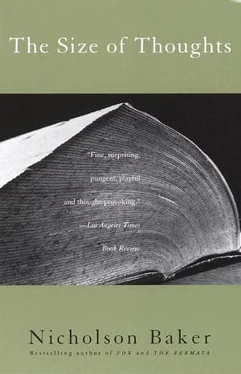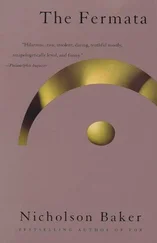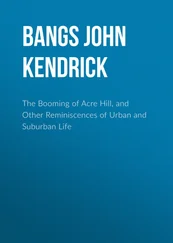Nicholson Baker - The Size of Thoughts - Essays and Other Lumber
Здесь есть возможность читать онлайн «Nicholson Baker - The Size of Thoughts - Essays and Other Lumber» весь текст электронной книги совершенно бесплатно (целиком полную версию без сокращений). В некоторых случаях можно слушать аудио, скачать через торрент в формате fb2 и присутствует краткое содержание. Год выпуска: 1997, Издательство: Vintage, Жанр: Публицистика, Критика, на английском языке. Описание произведения, (предисловие) а так же отзывы посетителей доступны на портале библиотеки ЛибКат.
- Название:The Size of Thoughts: Essays and Other Lumber
- Автор:
- Издательство:Vintage
- Жанр:
- Год:1997
- ISBN:нет данных
- Рейтинг книги:4 / 5. Голосов: 1
-
Избранное:Добавить в избранное
- Отзывы:
-
Ваша оценка:
- 80
- 1
- 2
- 3
- 4
- 5
The Size of Thoughts: Essays and Other Lumber: краткое содержание, описание и аннотация
Предлагаем к чтению аннотацию, описание, краткое содержание или предисловие (зависит от того, что написал сам автор книги «The Size of Thoughts: Essays and Other Lumber»). Если вы не нашли необходимую информацию о книге — напишите в комментариях, мы постараемся отыскать её.
The Size of Thoughts: Essays and Other Lumber — читать онлайн бесплатно полную книгу (весь текст) целиком
Ниже представлен текст книги, разбитый по страницам. Система сохранения места последней прочитанной страницы, позволяет с удобством читать онлайн бесплатно книгу «The Size of Thoughts: Essays and Other Lumber», без необходимости каждый раз заново искать на чём Вы остановились. Поставьте закладку, и сможете в любой момент перейти на страницу, на которой закончили чтение.
Интервал:
Закладка:
And why, in fact, did the Greeks relinquish so sensible a practice as word-spacing, which even the cuneiformists of Minoan Crete apparently used? Lejeune, for one, finds this development “remarquable”; but even more remarquable is the fact that the pragmatic Romans had word-spacing available to them (via the Etruscans), in the form of “interpuncts,” or hovering dots between each word (a practice successfully revived by Wang word-processing software in the 1980s), which they too abandoned in early Christian times. “For this amazing and deplorable regression one can conjecture no reason other than an inept desire to imitate even the worst characteristic of Greek books,” scolds Revilo P. Oliver. Dr. Parkes, on the other hand, theorizes that class differences between readers and scribes may have had something to do with the perseverance of scriptio continua —a scribal slave must not presume to word-space, or otherwise punctuate, because he would thereby be imposing his personal reading of the constitutive letters on his employer. There were also, in monkish contexts, quasi-mystical arguments to be made for unspaced impenetrability: a resistant text, slow to offer up its literal meaning, encouraged meditation and memorization, suggested Cassian (a prominent fifth-century recluse); and the moment when, after much futile staring, the daunting word-search-puzzle of the sacred page finally spaced itself out, coalescing into comprehensible units of the Psalter, might serve to remind the swooning lector of the miracle of the act of reading, which is impossible without God’s loving condescension into human language and human form.
Amid all this phylogeny, Parkes does not mention, nor should he necessarily mention, the more mundane developmental fact that scriptio continua comes naturally to children:
DEARANDREWH
APPYBIRTHDA
YILOVEYOULO
VEALICEXXOX
Children aren’t taught to forgo spacing; all their written models are properly spaced. Occasionally, as a concession to the recipient (or adult onlooker), they will go back and insert a virgule here and there between words for clarity. There is something so exciting about writing, perhaps, that, like barely literate five-year-olds, civilizations in the midst of discovering or rediscovering its pleasures and traditions take a while before they begin to care about casual readability — and consequently their scholars are said to study litterae , “letters,” not words.
In part as a result of the unspaced line, pointing was viewed from the beginning as a form of ornament, as well as a means of what Parkes calls “disambiguation.” Cassiodorus, the first great biblical pointillist, advised sixth-century monks to add punctuation “in order that you may be seen to be adding embellishment.” Alcuin wrote Charlemagne that “ Distinctiones or subdistinctiones by points can make embellishment in sentences most beautiful.” Early medieval readers like Dulcitius of Aquino would decorate a work with dots and diples and paragraph marks as they read it and then proudly sign their name on the page: “I, Dulcitius, read this.” Punctuation, like marginal and interlinear commentary, seems at times to have been a ritual of reciprocation, a way of returning something to the text in grateful tribute after it had released its meaning in the reader’s mind.
Somewhat surprisingly, scholastic philosophy of the thirteenth and fourteenth centuries, which is, as Francis Bacon uncharitably observed, a vast and intricate cobweb spun from Aristotle, “admirable for the fineness of thread and work, but of no substance and profit,” and thus ideally decorative and mannerist rather than functional, pushed by logical and dis-putational energy rather than pulled by truth — the sort of era, then, in which you might expect punctuation to thrive —turns out in fact to be a dark, sad time for subdistinctiones . Parkes explains that the paradigmatic nature of the scholastic manuscript, with its repetitive queriturs and quaestios signaling to the reader precisely where he was in the formal structure of the argument, made a sophisticated punctuational tool-set unnecessary.
On the other hand, it may just be that the schoolmen, spending their days reading awful Latin translations from the Arabic of translations from the Greek, had no ear. Cicero himself disdained punctuation, insisting that the well-cadenced sentence would audibly manifest its own terminus, without the need of any mere “stroke interposed by a copyist”; but those who afterward took punctuation, and took Cicero, seriously — Cassiodorus, Isidore, Bembo, Petrarch — proved their allegiance by their virgulae: like archaizing composers who want to ensure a certain once-standard performance practice and therefore spell out every trill and every ritenuto , though their historical models offer only unadorned notes, these admirers could hear the implied punctuation of Ciceronian rhythm, and could in some cases duplicate his rollaway effects in their own writing, but they didn’t trust their contemporaries to detect a classicizing clausula without the help of visual aids.
Dr. Parkes’s own prose is serviceable and unprecious, if non-passerine. For those of us whose Latin never quite took flight, he has provided translations of every passage he quotes. He takes care from time to time to mention political developments as they impinge on the punctuational sphere: if some depredation or upheaval happens to have brought on “a situation hostile to grammatical culture,” he says so. The puzzling thing, though, is how casual Parkes is — this eagle-eyed paleographer, who has worked so hard to “raise a reader’s consciousness of what punctuation is and does”!—about his commas. Where are they? “Pausing therefore was part of the process of reading not copying.” “Before the advent of printing a text left its author and fell among scribes.” “The printing process not only stabilized the shapes and functions of the symbols it also sustained existing conventions that governed the ways in which they were employed.” And: “This increase in the range of distinctive symbols also promoted new developments in usage since the symbols not only enabled readers to identify more easily the functions of grammatical constituents within a sentence but also made possible more subtle refinements in the communication of the message of a text.”
Were it not for Dr. Parkes’s surefooted employment of the comma elsewhere, one might almost suspect that his was a case reminiscent of those psychotherapists who enter their profession because they sense something deeply amiss within themselves, or of those humorless people who buy joke books and go to comedy clubs to correct internal deficiencies. In a commentary accompanying a fascinating page of Richard Hooker, Parkes, or someone with whom he has shared (as he nicely says in his preface) “the burden of proofs,” flouts even the sacred law of the serial comma: “The notation series for indicating glosses notes and citations in the margins, based on letters of the alphabet in sequence, was also used in the Geneva Bible of 1560.”
Once, however, Parkes surprises us by unconsciously using the old-fashioned, eighteenth-century that -comma. It is the comma of Gibbon—
It has been calculated by the ablest politicians, that no state, without being soon exhausted, can maintain above the hundredth part of its members in arms and idleness.
And of Gibbon’s model Montesquieu, in Nugent’s 1750 translation (twice)—
Plato thanked the Gods, that he was born in the same age with Socrates: and for my part, I give thanks to the Almighty, that I was born a subject of that government under which I live; and that it is his pleasure I should obey those, whom he has made me love.
Читать дальшеИнтервал:
Закладка:
Похожие книги на «The Size of Thoughts: Essays and Other Lumber»
Представляем Вашему вниманию похожие книги на «The Size of Thoughts: Essays and Other Lumber» списком для выбора. Мы отобрали схожую по названию и смыслу литературу в надежде предоставить читателям больше вариантов отыскать новые, интересные, ещё непрочитанные произведения.
Обсуждение, отзывы о книге «The Size of Thoughts: Essays and Other Lumber» и просто собственные мнения читателей. Оставьте ваши комментарии, напишите, что Вы думаете о произведении, его смысле или главных героях. Укажите что конкретно понравилось, а что нет, и почему Вы так считаете.












